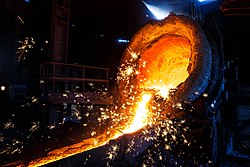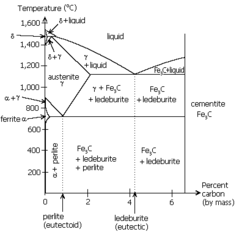Pearlite: Difference between revisions
mNo edit summary |
m changed word "phase" to "microstructure". Pearlite is not a phase, it is a microstructure |
||
| Line 11: | Line 11: | ||
Pearlite was first identified by [[Henry Clifton Sorby]] and initially named sorbite, however the similarity of microstructure to [[mother of pearl|nacre]] and especially the optical effect caused by the scale of the structure made the alternative name more popular. |
Pearlite was first identified by [[Henry Clifton Sorby]] and initially named sorbite, however the similarity of microstructure to [[mother of pearl|nacre]] and especially the optical effect caused by the scale of the structure made the alternative name more popular. |
||
Pearlite is a common |
Pearlite is a common microstructure occurring in many grades of steels. |
||
[[Bainite]] is a similar structure with lamellae much smaller than the [[wavelength]] of [[visible light]] and thus lacks this pearlescent appearance. It is prepared by more rapid cooling. Unlike pearlite, whose formation involves the diffusion of all atoms, bainite grows by a displacive transformation mechanism. |
[[Bainite]] is a similar structure with lamellae much smaller than the [[wavelength]] of [[visible light]] and thus lacks this pearlescent appearance. It is prepared by more rapid cooling. Unlike pearlite, whose formation involves the diffusion of all atoms, bainite grows by a displacive transformation mechanism. |
||
Revision as of 15:43, 7 April 2010
| Steels |
|---|
 |
| Phases |
| Microstructures |
| Classes |
| Other iron-based materials |


Pearlite is a two-phased, lamellar (or layered) structure composed of alternating layers of alpha-ferrite (88 wt%) and cementite (12%) that occurs in some steels and cast irons. During slow cooling pearlite forms by a eutectoid reaction as austenite is below 727°C (the eutectoid temperature).
The eutectoid composition of austenite is approximately 0.8% carbon; steel with less carbon content will contain a corresponding proportion of relatively pure ferrite crystallites that do not participate in the eutectoid reaction and cannot transform into pearlite. Likewise steels with higher carbon contents will form cementite before reaching the eutectoid point. The proportion of ferrite and cementite forming above the eutectoid point can be calculated from the iron/iron—carbide equilibrium phase diagram using the lever-rule.
Pearlite was first identified by Henry Clifton Sorby and initially named sorbite, however the similarity of microstructure to nacre and especially the optical effect caused by the scale of the structure made the alternative name more popular.
Pearlite is a common microstructure occurring in many grades of steels.
Bainite is a similar structure with lamellae much smaller than the wavelength of visible light and thus lacks this pearlescent appearance. It is prepared by more rapid cooling. Unlike pearlite, whose formation involves the diffusion of all atoms, bainite grows by a displacive transformation mechanism.
References
This article includes a list of references, related reading, or external links, but its sources remain unclear because it lacks inline citations. (September 2009) |
Comprehensive information on pearlite
